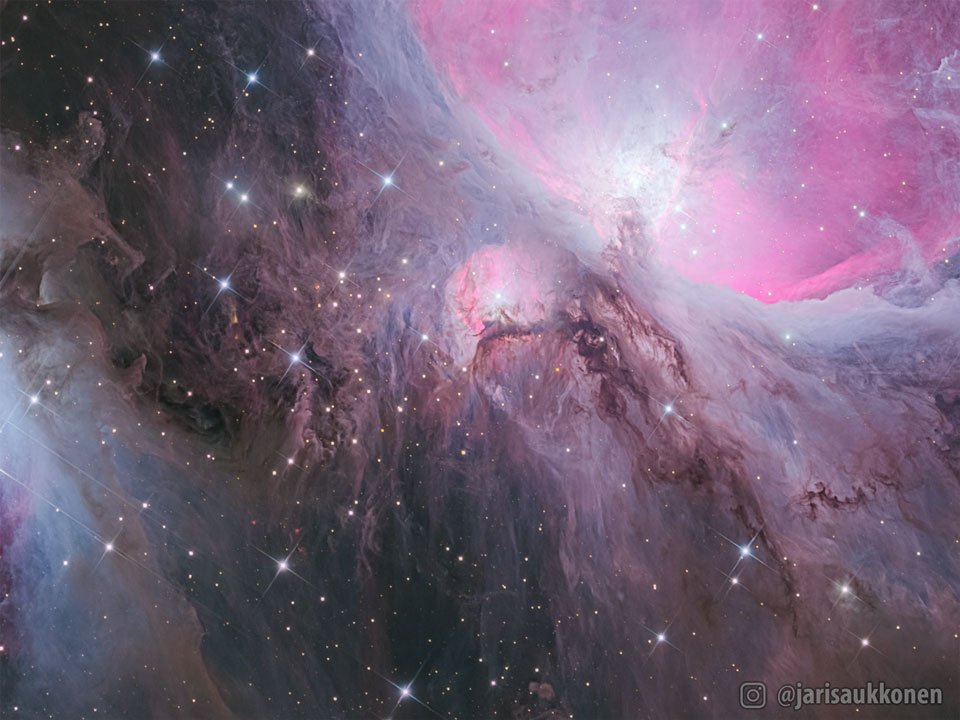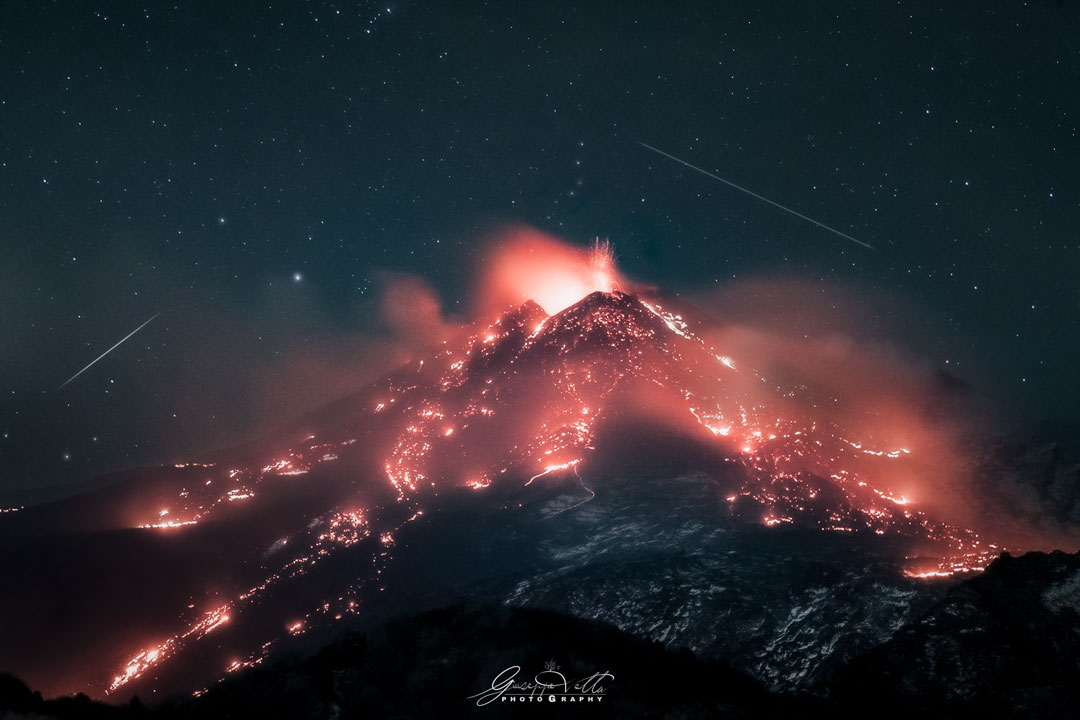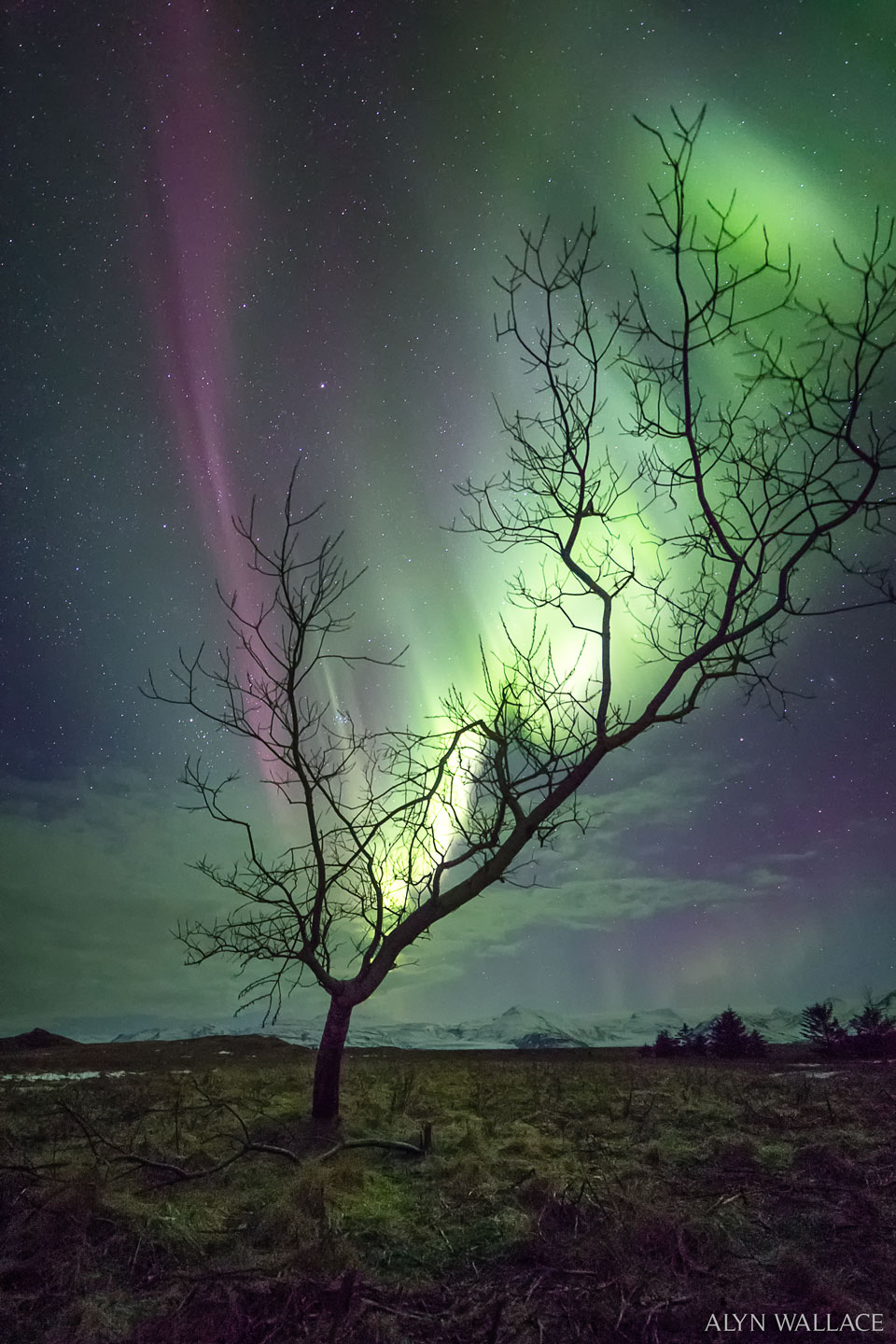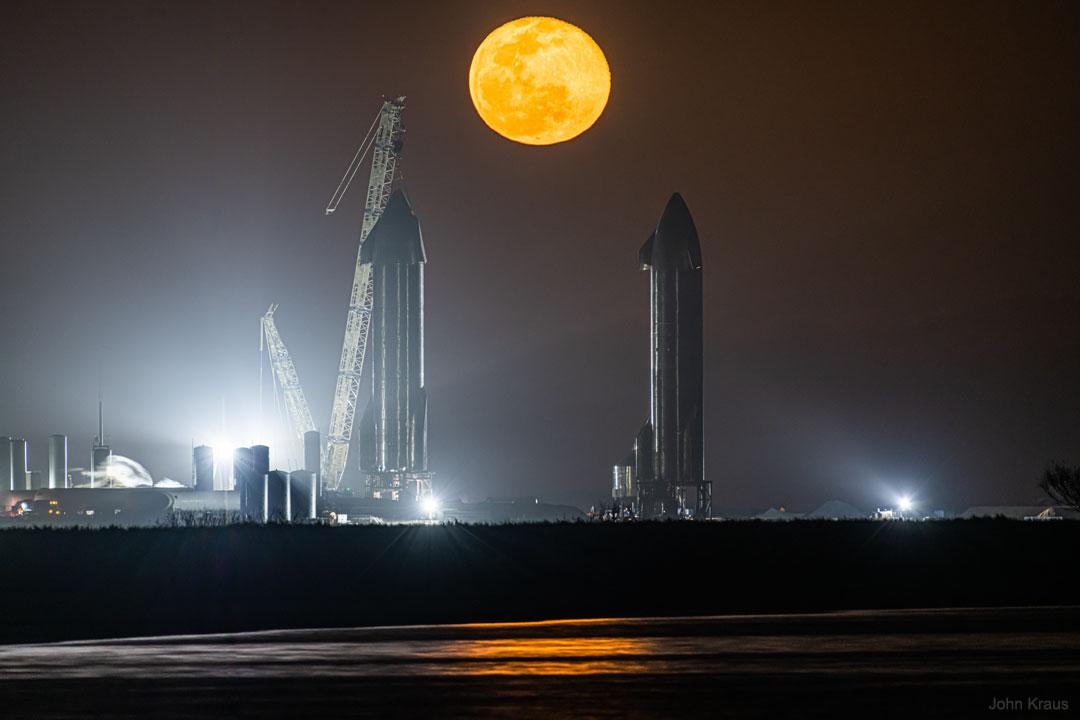

Debian welcomes the 2022 #Outreachy interns
Debian Project at 2022-05-30T10:21:11Z
Debian welcomes the 2022 #Outreachy interns https://bits.debian.org/2022/05/welcome-outreachy-interns-2022.html
RiveraValdez, nukem likes this.

Astronomy Picture of the Day for 2021-10-06 12:30:01.784180
Astronomy Picture of the Day (Unofficial) at 2021-10-06T17:30:02Z
Astronomy Picture of the Day
Discover the cosmos! Each day a different image or photograph of our fascinating universe is featured, along with a brief explanation written by a professional astronomer.
M43: Streams of Orion
Image Credit & Copyright: Jari SaukkonenExplanation: Where do the dark streams of dust in the Orion Nebula originate? This part of the Orion Molecular Cloud Complex, M43, is the often imaged but rarely mentioned neighbor of the more famous M42. M42, seen in part to the upper right, includes many bright stars from the Trapezium star cluster. M43 is itself a star forming region that displays intricately-laced streams of dark dust -- although it is really composed mostly of glowing hydrogen gas. The entire Orion field is located about 1600 light years away. Opaque to visible light, the picturesque dark dust is created in the outer atmosphere of massive cool stars and expelled by strong outer winds of protons and electrons.
Tomorrow's picture: open space
< | Archive | Submissions | Index | Search | Calendar | RSS | Education | About APOD | Discuss | >Authors & editors: Robert Nemiroff (MTU) & Jerry Bonnell (UMCP)
NASA Official: Phillip Newman Specific rights apply.
NASA Web Privacy Policy and Important Notices
A service of: ASD at NASA / GSFC
& Michigan Tech. U.
nukem likes this.
nukem shared this.

 The evil robots are coming to get me.
The evil robots are coming to get me.Jackson de Jesus, McClane, nukem likes this.
McClane shared this.


Astronomy Picture of the Day for 2021-03-08 12:30:02.356952
Astronomy Picture of the Day (Unofficial) at 2021-03-08T18:30:03Z
Astronomy Picture of the Day
Discover the cosmos! Each day a different image or photograph of our fascinating universe is featured, along with a brief explanation written by a professional astronomer.
Three Tails of Comet NEOWISE
Image Credit & Copyright: Nicolas LefaudeuxExplanation: What created the unusual red tail in Comet NEOWISE? Sodium. A spectacular sight back in the summer of 2020, Comet NEOWISE, at times, displayed something more than just a surprisingly striated white dust tail and a pleasingly patchy blue ion tail. Some color sensitive images showed an unusual red tail, and analysis showed much of this third tail's color was emitted by sodium. Gas rich in sodium atoms might have been liberated from Comet NEOWISE's warming nucleus in early July by bright sunlight, electrically charged by ultraviolet sunlight, and then pushed out by the solar wind. The featured image was captured in mid-July from Brittany, France and shows the real colors. Sodium comet tails have been seen before but are rare -- this one disappeared by late July. Comet C/2020 F3 (NEOWISE) has since faded, lost all of its bright tails, and now approaches the orbit of Jupiter as it heads back to the outer Solar System, to return only in about 7,000 years.
Astrophysicists: Browse 2,400+ codes in the Astrophysics Source Code Library
Tomorrow's picture: mars 360
< | Archive | Submissions | Index | Search | Calendar | RSS | Education | About APOD | Discuss | >Authors & editors: Robert Nemiroff (MTU) & Jerry Bonnell (UMCP)
NASA Official: Phillip Newman Specific rights apply.
NASA Web Privacy Policy and Important Notices
A service of: ASD at NASA / GSFC
& Michigan Tech. U.
nukem likes this.

Astronomy Picture of the Day for 2021-03-05 12:30:01.534420
Astronomy Picture of the Day (Unofficial) at 2021-03-05T18:30:02Z
Astronomy Picture of the Day
Discover the cosmos! Each day a different image or photograph of our fascinating universe is featured, along with a brief explanation written by a professional astronomer.
A Little Like Mars
Image Credit & Copyright: Robert BarsaExplanation: The surface of this planet looks a little like Mars. It's really planet Earth though. In a digitally stitched little planet projection, the 360 degree mosaic was captured near San Pedro in the Chilean Atacama desert. Telescopes in domes on the horizon are taking advantage of the arid region's famously dark, clear nights. Taken in early December, a magnificent Milky Way arcs above the horizon for almost 180 degrees around the little planet with Orion prominent in the southern sky. A familiar constellation upside down for northern hemisphere skygazers, Orion shares that southern December night almost opposite the Large and Small Magellanic clouds. But the Red Planet itself is the brightest yellowish celestial beacon in this little planet sky.
Please take a short survey in aesthetics & astronomy: Sonification
Tomorrow's picture: light-weekend
< | Archive | Submissions | Index | Search | Calendar | RSS | Education | About APOD | Discuss | >Authors & editors: Robert Nemiroff (MTU) & Jerry Bonnell (UMCP)
NASA Official: Phillip Newman Specific rights apply.
NASA Web Privacy Policy and Important Notices
A service of: ASD at NASA / GSFC
& Michigan Tech. U.
nukem likes this.

Galician TV series
EVAnaRkISTO@DM at 2021-03-05T18:00:43Z
Galician noir: how a rainy corner of Spain spawned a new TV genre

Filiming The Mess You Leave Behind in the Galician mountains. Photograph: Jaime Olmedo/Netflixnukem likes this.
EVAnaRkISTO shared this.

Wellness Journal, March 6, 2021
 "Wellness Journal, March 6, 2021" Walking: burned 141 calories in 31 minutes. Running: burned 959 calories running 5.25 miles. Intake: 3329 calories. Goal: 2330 net calories. Weight: 206.2 lbs https://steve.cooleysekula.net/blog/2021/03/06/wellness-journal-march-6-2021/ ( Feed URL: http://steve.cooleysekula.net/blog/rss2.xml )
"Wellness Journal, March 6, 2021" Walking: burned 141 calories in 31 minutes. Running: burned 959 calories running 5.25 miles. Intake: 3329 calories. Goal: 2330 net calories. Weight: 206.2 lbs https://steve.cooleysekula.net/blog/2021/03/06/wellness-journal-march-6-2021/ ( Feed URL: http://steve.cooleysekula.net/blog/rss2.xml )nukem likes this.

Foxtrot Bloom 2021

Foxtrot opened its first flower for this season and it has a slight fragrance!
It branched off its existing flower spike and it appears I will be getting 3 flowers.
Sadly, my other orchids didn't send out flower spikes this season.
nukem likes this.

Astronomy Picture of the Day for 2021-03-03 12:30:01.557361
Astronomy Picture of the Day (Unofficial) at 2021-03-03T18:30:02Z
Astronomy Picture of the Day
Discover the cosmos! Each day a different image or photograph of our fascinating universe is featured, along with a brief explanation written by a professional astronomer.
Stars over an Erupting Volcano
Image Credit & Copyright: Giuseppe VellaExplanation: Mt. Etna has been erupting for hundreds of thousands of years. Located in Sicily, Italy, the volcano produces lava fountains over one kilometer high. Mt. Etna is not only one of the most active volcanoes on Earth, it is one of the largest, measuring over 50 kilometers at its base and rising nearly 3 kilometers high. Pictured erupting last month, a lava plume shoots upwards, while hot lava flows down the volcano's exterior. Likely satellite trails appear above, while ancient stars dot the sky far in the distance. This volcanic eruption was so strong that nearby airports were closed to keep planes from flying through the dangerous plume. The image foreground and background were captured consecutively by the same camera and from the same location.
Please take a short survey in aesthetics & astronomy: Sonification
Tomorrow's picture: open space
< | Archive | Submissions | Index | Search | Calendar | RSS | Education | About APOD | Discuss | >Authors & editors: Robert Nemiroff (MTU) & Jerry Bonnell (UMCP)
NASA Official: Phillip Newman Specific rights apply.
NASA Web Privacy Policy and Important Notices
A service of: ASD at NASA / GSFC
& Michigan Tech. U.
Jackson de Jesus, nukem likes this.
nukem shared this.

Astronomy Picture of the Day for 2021-03-02 12:30:01.848481
Astronomy Picture of the Day (Unofficial) at 2021-03-02T18:30:02Z
Astronomy Picture of the Day
Discover the cosmos! Each day a different image or photograph of our fascinating universe is featured, along with a brief explanation written by a professional astronomer.
Ingenuity: A Mini-Helicopter Now on Mars
Illustration Credit: NASA, JPL-Caltech, Mars 2020 - PerseveranceExplanation: What if you could fly around Mars? NASA may have achieved that capability last month with the landing of Perseverance, a rover which included a small flight-worthy companion called Ingenuity, nicknamed Ginny. Even though Ginny is small -- a toaster-sized helicopter with four long legs and two even-longer (1.2-meter) rotors, she is the first of her kind -- there has never been anything like her before. After being deployed, possibly in April, the car-sized Perseverance ("Percy") will back away to give Ginny ample room to attempt her unprecedented first flight. In the featured artistic illustration, Ginny's long rotors are depicted giving her the lift she needs to fly into the thin Martian atmosphere and explore the area near Perseverance. Although Ingenuity herself will not fly very far, she is a prototype for all future airborne Solar-System robots that may fly far across not only Mars, but Titan.
Tomorrow's picture: erupting earth
< | Archive | Submissions | Index | Search | Calendar | RSS | Education | About APOD | Discuss | >Authors & editors: Robert Nemiroff (MTU) & Jerry Bonnell (UMCP)
NASA Official: Phillip Newman Specific rights apply.
NASA Web Privacy Policy and Important Notices
A service of: ASD at NASA / GSFC
& Michigan Tech. U.
Jackson de Jesus, nukem likes this.
nukem shared this.

Karl Fogel at 2021-03-02T18:03:27Z
"Many times I’ve analogized the Trump presidency to living in a household with an abuser. Part of that experience is hyper-vigilance and attention to the actions and moods of the abuser. That person has the power. That person controls the violence. Absent that power, though, Trump’s lies and general crap don’t really matter to me as much. Absent that power, he’s just another entitled jerk who wants space in my head."nukem likes this.

Astronomy Picture of the Day for 2021-02-28 12:30:02.424382
Astronomy Picture of the Day (Unofficial) at 2021-02-28T18:30:12Z
Astronomy Picture of the Day
Discover the cosmos! Each day a different image or photograph of our fascinating universe is featured, along with a brief explanation written by a professional astronomer.
The Aurora Tree
Image Credit & Copyright: Alyn WallaceExplanation: Yes, but can your tree do this? Pictured is a visual coincidence between the dark branches of a nearby tree and bright glow of a distant aurora. The beauty of the aurora -- combined with how it seemed to mimic a tree right nearby -- mesmerized the photographer to such a degree that he momentarily forgot to take pictures. When viewed at the right angle, it seemed that this tree had aurora for leaves. Fortunately, before the aurora morphed into a different overall shape, he came to his senses and capture the awe-inspiring momentary coincidence. Typically triggered by solar explosions, aurora are caused by high energy electrons impacting the Earth's atmosphere around 150 kilometers up. The unusual Earth-sky collaboration was witnessed in March of 2017 in Iceland.
Almost Hyperspace: Random APOD Generator
Tomorrow's picture: interstellar fowl
< | Archive | Submissions | Index | Search | Calendar | RSS | Education | About APOD | Discuss | >Authors & editors: Robert Nemiroff (MTU) & Jerry Bonnell (UMCP)
NASA Official: Phillip Newman Specific rights apply.
NASA Web Privacy Policy and Important Notices
A service of: ASD at NASA / GSFC
& Michigan Tech. U.
Jackson de Jesus, nukem likes this.
nukem shared this.

Astronomy Picture of the Day for 2021-02-26 12:30:01.586802
Astronomy Picture of the Day (Unofficial) at 2021-02-26T18:30:02Z
Astronomy Picture of the Day
Discover the cosmos! Each day a different image or photograph of our fascinating universe is featured, along with a brief explanation written by a professional astronomer.
Mars Perseverance Sol 3
Image Credit: NASA, JPL-Caltech, MSSS, ASUExplanation: Stitched together on planet Earth, 142 separate images make up this 360 degree panorama from the floor of Jezero Crater on Mars. The high-resolution color images were taken by the Perseverance rover's zoomable Mastcam-Z during mission sol 3, also known as February 21, 2021. In the foreground of Mastcam-Z's view is the car-sized rover's deck. Broad light-colored patches in the martian soil just beyond it were scoured by descent stage rocket engines during the rover's dramatic arrival on February 18. The rim of 45 kilometer-wide Jezero Crater rises in the distance. In the coming sols, Perseverance will explore the ancient lake-delta system in the crater, hunting for signs of past microscopic life and collecting samples for potential future return to planet Earth.
Tomorrow's picture: light-weekend
< | Archive | Submissions | Index | Search | Calendar | RSS | Education | About APOD | Discuss | >Authors & editors: Robert Nemiroff (MTU) & Jerry Bonnell (UMCP)
NASA Official: Phillip Newman Specific rights apply.
NASA Web Privacy Policy and Important Notices
A service of: ASD at NASA / GSFC
& Michigan Tech. U.
nukem likes this.

Biden’s pick for HHS sued the Trump administration, not a group of nuns
Assessment of U.S. Politics at 2021-02-26T09:15:07Z
"Biden’s pick for HHS sued the Trump administration, not a group of nuns"
There’s a difference between suing nuns and suing the federal government in a case that nuns decide to join.
( Feed URL: http://feeds.washingtonpost.com/rss/rss_fact-checker )nukem likes this.

Astronomy Picture of the Day for 2021-02-25 12:30:02.453590
Astronomy Picture of the Day (Unofficial) at 2021-02-25T18:30:03Z
Astronomy Picture of the Day
Discover the cosmos! Each day a different image or photograph of our fascinating universe is featured, along with a brief explanation written by a professional astronomer.
A Venus Flyby
Image Credit: NASA, JHUAPL, Naval Research Lab, Guillermo Stenborg and Brendan GallagherExplanation: On a mission to explore the inner heliosphere and solar corona, on July 11, 2020 the Wide-field Imager on board NASA's Parker Solar Probe captured this stunning view of the nightside of Venus at distance of about 12,400 kilometers (7,693 miles). The spacecraft was making the third of seven gravity-assist flybys of the inner planet. The gravity-asssist flybys are designed to use the approach to Venus to help the probe alter its orbit to ultimately come within 6 million kilometers (4 million miles) of the solar surface in late 2025. A surprising image, the side-looking camera seems to peer through the clouds to show a dark feature near the center known as Aphrodite Terra, the largest highland region on the Venusian surface. The bright rim at the edge of the planet is nightglow likely emitted by excited oxygen atoms recombining into molecules in the upper reaches of the atmosphere. Bright streaks and blemishes throughout the image are likely due to energetic charged particles, and dust near the camera reflecting sunlight. Skygazers from planet Earth probably recognize the familiar stars of Orion's belt and sword at lower right.
Tomorrow's picture: fly over
< | Archive | Submissions | Index | Search | Calendar | RSS | Education | About APOD | Discuss | >Authors & editors: Robert Nemiroff (MTU) & Jerry Bonnell (UMCP)
NASA Official: Phillip Newman Specific rights apply.
NASA Web Privacy Policy and Important Notices
A service of: ASD at NASA / GSFC
& Michigan Tech. U.
nukem likes this.


Stephen Sekula at 2021-02-23T13:01:40Z
“First real-world coronavirus vaccine data in Britain show decline in infections, hospitalizations after first dose…” Early, but promising. https://www.washingtonpost.com/world/europe/covid-vaccines-protection-uk/2021/02/22/216b1dac-751a-11eb-9489-8f7dacd51e75_story.htmlnukem likes this.
Doug Whitfield shared this.

Astronomy Picture of the Day for 2021-02-22 12:30:01.834231
Astronomy Picture of the Day (Unofficial) at 2021-02-22T18:30:02Z
Astronomy Picture of the Day
Discover the cosmos! Each day a different image or photograph of our fascinating universe is featured, along with a brief explanation written by a professional astronomer.
Moon Rising Between Starships
Image Credit & Copyright: John KrausExplanation: What's that on either side of the Moon? Starships. Specifically, they are launch-and-return reusable rockets being developed by SpaceX to lift cargo and eventually humans from the Earth's surface into space. The two rockets pictured are SN9 (Serial Number 9) and SN10 which were captured near their Boca Chica, Texas launchpad last month posing below January's full Wolf Moon. The Starships house liquid-methane engines inside rugged stainless-steel shells. SN9 was test-launched earlier this month and did well with the exception of one internal rocket that failed to relight during powered descent. SN10 continues to undergo ground tests and may be test-launched later this month.
Tomorrow's picture: space fowl
< | Archive | Submissions | Index | Search | Calendar | RSS | Education | About APOD | Discuss | >Authors & editors: Robert Nemiroff (MTU) & Jerry Bonnell (UMCP)
NASA Official: Phillip Newman Specific rights apply.
NASA Web Privacy Policy and Important Notices
A service of: ASD at NASA / GSFC
& Michigan Tech. U.
McClane, nukem, Michele Montagna likes this.
nukem shared this.

Stephen Sekula at 2021-02-23T03:31:00Z
Ran 3.85 miles outside today. First time in weeks I have been able to find the time for an outdoor run on the same day the temperature was conducive for one. It was ~65F when I went running. We have come a LOOOONG way since last week's polar air mass.nukem likes this.









